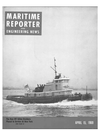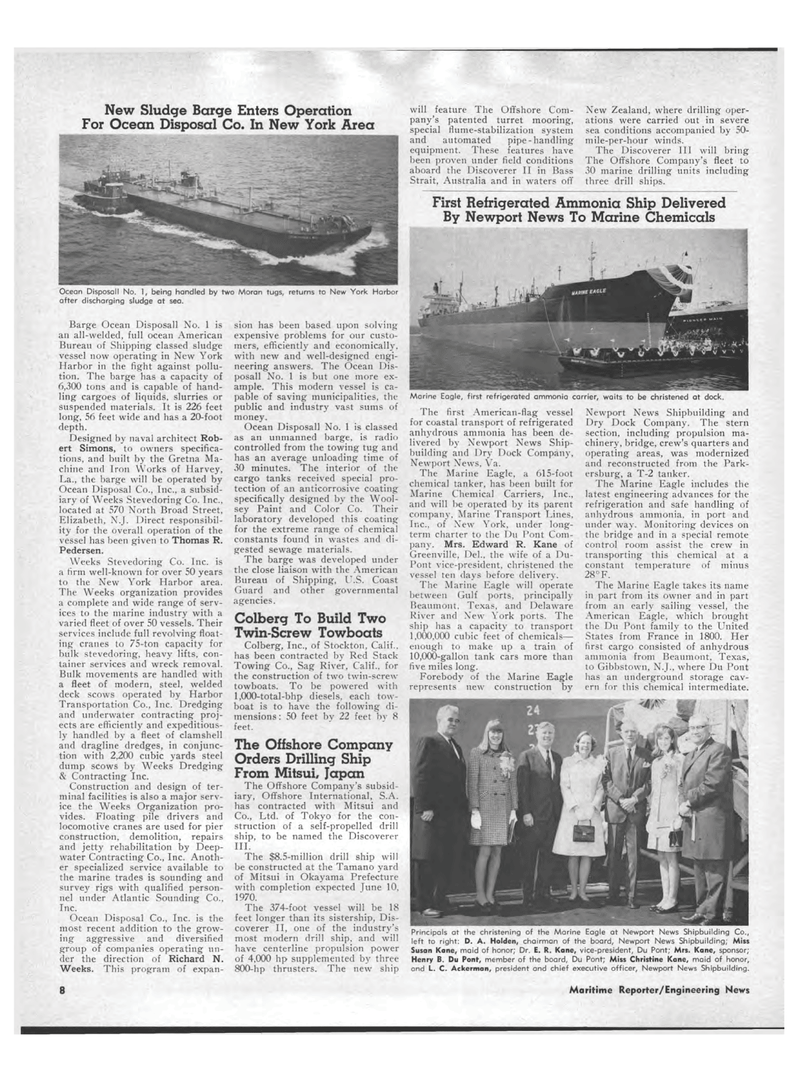
Page 6: of Maritime Reporter Magazine (April 15, 1969)
Read this page in Pdf, Flash or Html5 edition of April 15, 1969 Maritime Reporter Magazine
New Sludge Barge Enters Operation For Ocean Disposal Co. In New York Area Ocean Disposall No. 1, being handled by two Moran tugs, returns to New York Harbor after discharging sludge at sea. Barge Ocean Disposall No. 1 is an all-welded, full ocean American Bureau of Shipping classed sludge vessel now operating in New York Harbor in the fight against pollu-tion. The barge has a capacity of 6,300 tons and is capable of hand-ling cargoes of liquids, slurries or suspended materials. It is 226 feet long, 56 feet wide and has a 20-foot depth. Designed by naval architect Rob-ert Simons, to owners specifica-tions, and built by the Gretna Ma-chine and Iron Works of Harvey, La., the barge will be operated by Ocean Disposal Co., Inc., a subsid-iary of Weeks Stevedoring Co. Inc., located at 570 North Broad Street, Elizabeth, N. |. Direct responsibil-ity for the overall operation of the vessel has been given to Thomas R. Pedersen. Weeks Stevedoring Co. Inc. is a firm well-known for over 50 years to the New York Harbor area. The Weeks organization provides a complete and wide range of serv-ices to the marine industry with a varied fleet of over 50 vessels. Their services include full revolving float-ing cranes to 75-ton capacity for bulk stevedoring, heavy lifts, con-tainer services and wreck removal. Bulk movements are handled with a fleet of modern, steel, welded deck scows operated by Harbor Transportation Co., Inc. Dredging and underwater contracting proj-ects are efficiently and expeditious-ly handled by a fleet of clamshell and dragline dredges, in conjunc-tion with 2,200 cubic yards steel dump scows by Weeks Dredging & Contracting Inc. Construction and design of ter-minal facilities is also a major serv-ice the Weeks Organization pro-vides. Floating pile drivers and locomotive cranes are used for pier construction, demolition, repairs and jetty rehabilitation by Deep-water Contracting Co., Inc. Anoth-er specialized service available to the marine trades is sounding and survey rigs with qualified person-nel under Atlantic Sounding Co., Inc. Ocean Disposal Co., Inc. is the most recent addition to the grow-ing aggressive and diversified group of companies operating un-der the direction of Richard N. Weeks. This program of expan-8 sion has been based upon solving expensive problems for our custo-mers, efficiently and economically, with new and well-designed engi-neering answers. The Ocean Dis-posall No. 1 is but one more ex-ample. This modern vessel is ca-pable of saving municipalities, the public and industry vast sums of money. Ocean Disposall No. 1 is classed as an unmanned barge, is radio controlled from the towing tug and has an average unloading time of 30 minutes. The interior of the cargo tanks received special pro-tection of an anticorrosive coating specifically designed by the Wool-sey Paint and Color Co. Their laboratory developed this coating for the extreme range of chemical constants found in wastes and di-gested sewage materials. The barge was developed under the close liaison with the American Bureau of Shipping, U.S. Coast Guard and other governmental agencies. Colberg To Build Two Twin-Screw Towboats Colberg, Inc., of Stockton, Calif., has been contracted by Red Stack Towing Co., Sag River, Calif., for the construction of two twin-screw towboats. To be powered with 1,000-total-bhp diesels, each tow-boat is to have the following di-mensions : 50 feet bv 22 feet bv 8 feet. The Offshore Company Orders Drilling Ship From Mitsui, Japan The Offshore Company's subsid-iary, Offshore International, S.A. has contracted with Mitsui and Co., Ltd. of Tokyo for the con-struction of a self-propelled drill ship, to be named the Discoverer III. The $8.5-million drill ship will be constructed at the Tamano yard of Mitsui in Okayama Prefecture with completion expected June 10, 1970. The 374-foot vessel will be 18 feet longer than its sistership, Dis-coverer II, one of the industry's most modern drill ship, and will have centerline propulsion power of 4,000 hp supplemented by three 800-hp thrusters. The new ship will feature The Offshore Com-pany's patented turret mooring, special flume-stabilization system and automated pipe-handling equipment. These features have been proven under field conditions aboard the Discoverer II in Bass Strait, Australia and in waters off New Zealand, where drilling oper-ations were carried out in severe sea conditions accompanied by 50-mile-per-hour winds. The Discoverer III will bring The Offshore Company's fleet to 30 marine drilling units including three drill ships. First Refrigerated Ammonia Ship Delivered By Newport News To Marine Chemicals Marine Eagle, first refrigerated ammonia carrier, waits to be christened at dock. The first American-flag vessel for coastal transport of refrigerated anhydrous ammonia has been de-livered by Newport News Ship-building and Dry Dock Company, Newport News, Va. The Marine Eagle, a 615-foot chemical tanker, has been built for Marine Chemical Carriers, Inc., and will be operated by its parent company. Marine Transport Lines, Inc., of New York, under long-term charter to the Du Pont Com-pany. Mrs. Edward R. Kane of Greenville, Del., the wife of a Du-Pont vice-president, christened the vessel ten clays before delivery. The Marine Eagle will operate between Gulf ports, principally Beaumont. Texas, and Delaware River and New York ports. The ship has a capacity to transport 1,000.000 cubic feet of chemicals? enough to make up a train of 10,000-gallon tank cars more than five miles long. Forebodv of the Marine Eagle represents new construction by Newport News Shipbuilding and Dry Dock Company. The stern section, including propulsion ma-chinery, bridge, crew's quarters and operating areas, was modernized and reconstructed from the Park-ersburg, a T-2 tanker. The Marine Eagle includes the latest engineering advances for the refrigeration and safe handling of anhydrous ammonia, in port and under way. Monitoring devices on the bridge and in a special remote control room assist the crew in transporting this chemical at a constant temperature of minus 28°F. The Marine Eagle takes its name in part from its owner and in part from an early sailing vessel, the American Eagle, which brought the Du Pont family to the United States from France in 1800. Her first cargo consisted of anhydrous ammonia from Beaumont, Texas, to Gibbstown, N.J., where Du Pont has an underground storage cav-ern for this chemical intermediate. Principals at the christening of the Marine Eagle at Newport News Shipbuilding Co., left to right: D. A. Holden, chairman of the board, Newport News Shipbuilding; Miss Susan Kane, maid of honor; Dr. E. R. Kane, vice-president, Du Pont; Mrs. Kane, sponsor; Henry B. Du Pont, member of the board, Du Pont; Miss Christine Kane, maid of honor, and L. C. Ackerman, president and chief executive officer, Newport News Shipbuilding. Maritime Reporter/Engineering News

 5
5

 7
7
